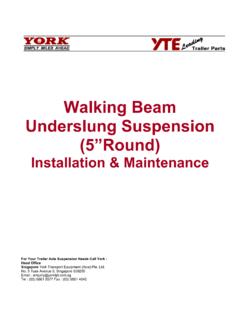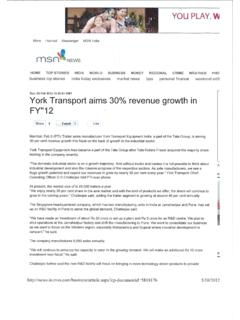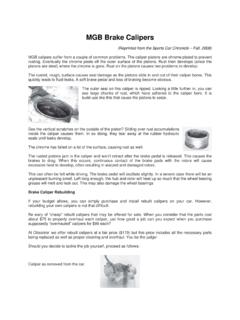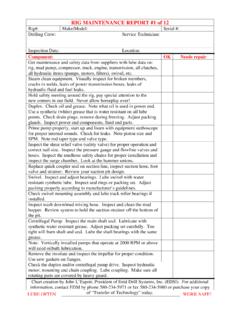Transcription of Every 5,000 km - York Transport Equipment
1 Our products are built to high standards and are engineered to give years of dependable service, but regular attention is recommended for continuous efficient running. Maintenance procedures are carefully set out in this booklet to enable the operator to obtain the most satisfactory performance from the Equipment and operators are expected to perform these recommended maintenance procedures as a condition of our warranty. When renewing parts, use only genuine parts, as they are correctly designed and manufactured to exacting standards of quality control to ensure optimum performance. When ordering parts, always quote the component or Equipment serial number and type designation. Illustrated parts lists are available on request.
2 The following schedule refers to axles fitted to any make trailer, for trailers running under normal conditions. During servicing, replace defective items with genuine parts. For details on trailer maintenance, refer to trailer manufacturer. First 500 km Check recommended torque settings, dry threads. Note: The use of power tools for torque settings is not recommended. 1 ft/1 b = Nm WHEEL NUTS (on delivery or after wheel change, check and re-torque the wheel nut monthly during operation). ISO M22 760/850 Nm ISO M24 840/930 Nm BSF 7/8" 760/850 Nm DIN M22 760/850 Nm Japanese M20 500/600 Nm Japanese M24 670/770 Nm 5 Spoke Hubs 3/4" UNC 270/300 Nm 6 Spoke Hubs M18 270/300 Nm 6 Spoke Hubs M20 320/360 Nm CAMSHAFT BRACKET SETSCREWS M12 90/100 Nm M10 30/35 Nm Lubricate camshaft grease nipples using Lithium soap based grease First 5,000 km Full wheel bearing adjustment (see Page 9 for procedure).
3 Every 5,000 km Check and adjust brakes and check brake linings for wear. Every 25,000 km Lubricate slack adjuster and camshaft using EP2 grease or equivalent (Do not over grease). Rotate wheels and check wheel bearings with lever to as certain if there is excessive bearing movement. Examine and re-adjust if found TRAILER AXLE PREVENTIVE MAINTENANCE SCHEDULE (Bearing lubricants-Timken 270 or MOBIL grease HP222 or equivalent) loose. Every 100,000 km or Every 2 Years Remove, wash and inspect wheel bearings, replace if necessary. When re-assembling, bearings must be properly lubricated and adjusted to our specifications. IMPORTANT NOTE: If the operating service conditions are severe, this procedure may be required at more frequent intervals.
4 Every 300,000 km or Every 2 Years Remove, wash and inspect wheel bearings, replace if necessary. When re-assembling, bearings must be properly lubricated and adjusted to our specifications. IMPORTANT NOTE: If the operating service conditions are severe, this procedure may be required at more frequent intervals. It is important to ensure that nuts and collars match the wheel to be fitted, ISO nut with integral washer should be matched with ISO wheel rim with straight hole and located on hub spigot; DIN nut and collar should be matched with R18 spherical seating; BSF conical nut and collars should be matched with standard wheel with conical seating; JAP globe nut should fit with spherical seat. This Wheel mounting fitting must not be interchanged or mixed in any combination WHEEL MOUNT FITTING Operators should establish a schedule for periodic adjustment, clearing, inspection and lubrication of brake Equipment ; such a schedule will eliminate trouble before it develops.
5 The following points should be observed to maintain the original standard. a) Brakes should be adjusted as frequently as required to maintain the original standard for safety. Uniform lining clearance and correct travel of levers must be maintained. b) At regular intervals remove the brake drums and check the lining for wear; the linings must not be allowed to wear down to the rivets. When fitting new brake shoes or after relining, always fit new return springs. c) Brakes should be cleaned, inspected, lubricated and adjusted each time the hubs are removed. During Every brake relining, inspect the following parts for wear, deterioration, cracks or other damage: a) Wheel stud and collar. b) Hub and drum. c) Bearing. d) Hub seals: It is recommended that new seals be fitted at this time.
6 E) brake cam roller and roller retaining springs. f) brake anchor pin and bushes. g) brake shoe and the hole tor anchor pin. Prior to re-assembly, the following pads should be lightly coated with Lithium soap based grease E a) brake cam roller and journals, b) brake shoe anchor pin hole and bush surface. GENERAL SERVICE REQUIREMENT c) Bore of camshaft nylon bush. Greasing should be continued until the clean lubricant is forced out of the fittings, showing that fresh clean grease has forced out the dirty grease in all the working parts. The dirty grease should be removed. IMPORTANT: Where assemblies are fitted with a seal, greasing at high pressure may damage the seals; in such cases, care must be taken not to lubricate excessively.
7 The use of good quality oils and greases is most strongly recommended. Poor quality, low priced lubricant may cause damage, as very often it lacks essential qualities. NOTE:1)All removed parts must be kept together in good clean condition ready for subsequent refitting after passing examination. 2)For workshop safety when jacking up trailers, always use two jacks positioned as close to spring seat center as possible. 3)When ordering spares, it is important to quote axle type number which is stamped on the axle serial plate. (If plate is missing, serial number is stamped onto beam at central point where the plate was fitted). EXAMPLE OF AXLE SPARE PART LISTI G (a) Remove set screws securing hub cap and gasket (b) Remove hub bearing locknuts and washer (c) Ensure brakes are slackened off HUB SERVICING Removal of Hub and Drum Spoked Wheels Hubs Servicing (d) Withdraw hub and drum assembly.
8 Ensure that outer bearing does not fall out of hub (e) Remove inner and outer bearing assemblies Hub and bearings should be thoroughly cleaned, examined then repacked with a recommended lubricant. A spoke wheel hub replaces the standard hub on some model of axles. A five spoke hub (Alternate 6,5 spoke or 3 spoke) is secured to the outside face of the brake drum by bolts and nuts. Thoroughly clean all parts and examine for wear or damage. Ensure the machined ends of the spokes are not burred. Any burrs should be removed by light filing. IMPORTANT: Do not paint the machined spoke ends. Paint can cause misalignment of the rims. Refitting hub and drum is in reverse order to removal. Ensure that procedure for bearing adjustment is strictly adhered to.
9 Clamp bolt nut - 6 spoke hub M18 270/300 Nm -5 spoke hub UNC 270/300 Nm Hub to drum fixing nuts - 6 spoke hub - 300/340 Nm - -5 spoke hub 3/4" UNC 300/340 Nm The torque figures given are the recommended lower and higher figures. Tightening nuts more than the higher figure is not recommended. When tightening clamp bolt nuts on spoke hub axles. TIGHTEN CROSSWISE, Tighten each nut lightly and turn clock wise or anti-clock wise and repeat the operation until the nuts are tight. Check torque setting of clamp bolt nuts after 80 km and tighten if necessary. The following servicing procedure is Carefully protect bearings from dirt and moisture whilst they are out of their housings.
10 It is advisable to wash them thoroughly immediately after removal, by the following procedure:- (a) Immerse in a washing fluid such as clean white spirit or good quality paraffin (DO NOT USE PETROL). The washing fluid must not attack the bearing components. After soaking, swirl each separate bearing around in the fluid, using a basket or other container if convenient. A clean fibre brush may be used, care being taken that no bristles lodge In the bearing. Occasional slow oscillation of the bearing rings will help dislodge dried out grease and other matter. Never spin a dry bearing which could cause the rollers to skid, thus damaging the highly finished internal surfaces of the bearing.









